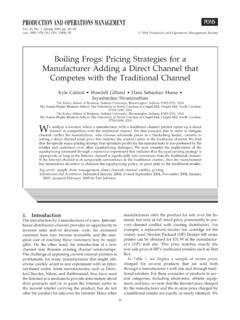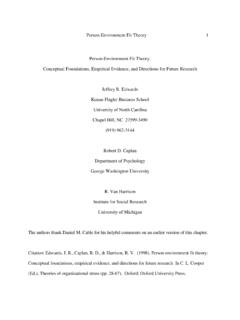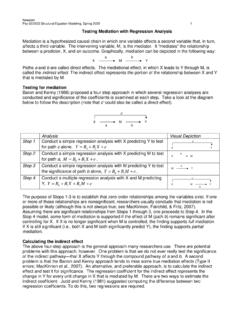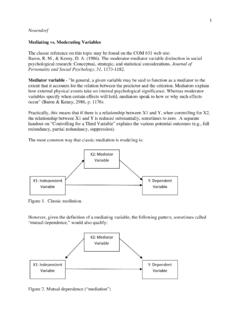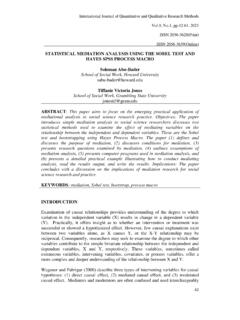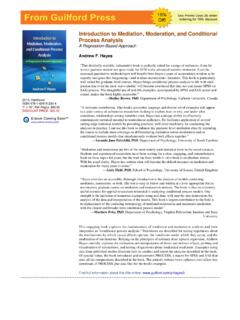Transcription of Mediation Fundamentals
1 Mediation Jeffrey R. Edwards 1 Mediation Fundamentals - Mediation refers to the transmission of the effect of an independent variable on a dependent variable through one or more other variables. These variables are termed mediator or intervening variables. - In the language of path analysis, Mediation corresponds to an indirect effect of an independent variable on a dependent variable that passes through one or more mediator variables. An indirect effect is calculated by multiplying the paths that constitute the effect. The magnitude of the indirect effect indicates the amount of Mediation through the relevant mediator variables. - Mediation can be either complete or partial. * With complete Mediation , the entire (or total) effect of an independent variable on a dependent variable is transmitted through one or more mediator variables.
2 Thus, the independent variable has no direct effect on the dependent variable; rather, its entire effect is indirect. * With partial Mediation , an independent variable has both direct and indirect effects on a dependent variable. The direct effect is not mediated, whereas the indirect effect is transmitted through one or more mediator variables. - Mediation can refer to a single mediator variable or multiple mediator variables. * Multiple mediator variables can operate jointly at the same stage in a causal model, such that there are several indirect effects linking an independent variable to a dependent variable. * Multiple mediator variables can be linked sequentially, such that the indirect effect of an independent variable on a dependent variable operates through a chain of mediator variables.
3 These two possibilities can be combined to form complex causal models with both simultaneous and sequential Mediation . Mediation Jeffrey R. Edwards 2 Methods for Analyzing Mediation - The most common approach to analyzing Mediation is the causal steps procedure popularized by Baron and Kenny (1986). This approach involves the following set of regression equations relating the independent variable, mediator variable, and dependent variable: Y = b01 + cX + e1 (1) M = b02 + aX + e2 (2) Y = b03 + bM + c'X + e3 (3) Eq. 1 corresponds to the model in Figure 1, and Eqs. 2 and 3 are represented by the model in Figure 2. - Results from these equations are used to evaluate the following conditions for M as a mediator of the relationship between X and Y: * The independent variable X should relate to the dependent variable Y, such that c in Equation 1 is significant.
4 This condition is used to establish that there is a relationship between X and Y to be mediated. * The independent variable X should relate to the mediator variable M, such that a in Equation 2 is significant. This condition establishes the first stage of the mediated effect. * The mediator variable M should relate to the dependent variable Y, such that b in Eq. 3 is significant. This condition establishes the second stage of the mediated effect. * The independent variable X should no longer relate to the dependent variable Y after the mediator variable M is controlled, such that c' in Eq. 3 is not significant. This condition shows that the relationship between X and Y examined under the first condition disappears when the mediated effect transmitted through M is taken into account.
5 Satisfying all four conditions provides evidence for complete Mediation , whereas satisfying the first three conditions indicates partial Mediation . Mediation Jeffrey R. Edwards 3 - Although the causal steps procedure is widely used, it suffers from several shortcomings that can yield erroneous conclusions regarding the presence or absence of Mediation . These shortcomings are summarized as follows. * An independent variable can have countervailing direct and indirect effects on a dependent variable, such that the effects have opposite signs. If the direct and indirect effects are approximately equal in magnitude, then the first condition for Mediation might not be satisfied, despite the presence of a mediated effect linking the independent and dependent variables.
6 This possibility raises questions regarding the need to satisfy the first condition of the causal steps procedure. * When an independent and dependent variable are linked by multiple mediator variables, the first condition for Mediation might not be satisfied even though each link in the causal chain differs from zero. This possibility again raises questions regarding the need to satisfy the first condition of the causal steps procedure. * When testing the relationship between the mediator variable and the dependent variable, controlling for the independent variable can reduce this relationship to nonsignificance. For this reason, some researchers have argued that the test of the relationship between the mediator variable and the dependent variable should exclude the independent variable (assuming a complete Mediation model is hypothesized).
7 The fourth condition for Mediation could then be assessed by determining if the fit of the model would improve if a path from the independent variable to the dependent variable were added to the model. * Controlling for the mediator variable can reduce the relationship between the independent and dependent variables to nonsignificance even when the reduction in this relationship is small. As a result, the fourth condition can be satisfied when the magnitude of the mediated effect is trivial. This shortcoming can be addressed by reframing the fourth condition as the degree to which controlling for the mediator variable reduces the relationship between the independent and dependent variables. When the mediator variable is excluded, this relationship is the total effect of the independent variable on the dependent variable, and when the mediator variable is included, this relationship is the direct effect of the independent variable.
8 Given that the total effect equals the sum of the direct and indirect effects: TE = DE + IE (4) Mediation Jeffrey R. Edwards 4 It follows that the difference between the total and direct effects is the indirect effect: IE = TE DE (5) This equality can be expressed in terms of the regression equations used in the causal steps procedure as follows: ab = c c' (6) As shown in this expression, the indirect effect of X on Y transmitted through M is the product of the coefficient linking X to M times the coefficient linking M to Y. Hence, the reduction of the relationship between the independent variable and dependent variable when the mediator variable is controlled is equivalent to the indirect effect of the independent variable on the dependent variable transmitted through the mediator variable.
9 * The causal steps procedure does not yield an estimate of the size of the mediated effect. As shown above, this effect can be computed as the product of paths a and b or as the difference between paths c and c'. Although this quantity can be readily obtained from results obtained through the causal steps procedure, it is not part of the criteria used to establish Mediation . * The criteria for Mediation associated with the causal steps procedure are difficult to apply when multiple mediator variables are involved. For instance, evidence for the second criterion, which involves the relationship between the independent and mediator variables, can differ depending on which mediator variable is under consideration.
10 Likewise, evidence for the third criterion, which concerns the relationship between the mediator and dependent variables, can vary according to the mediator variable under consideration. Differences in results across mediator variables can yield mixed conclusions as to whether the relationship between the independent and dependent variables is mediated. Moreover, the reduction of the relationship between the independent and dependent variables after controlling for a set of mediator variables indicates the size of the mediated effects as a whole, not the size of any particular mediated effect. These individual mediated effects are often important from a theoretical perspective. Mediation Jeffrey R. Edwards 5 - The shortcomings of the causal steps procedure have stimulated alternative approaches to analyzing Mediation .
